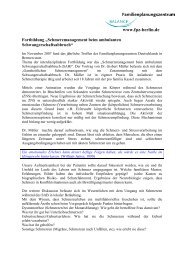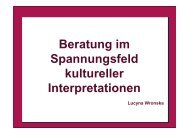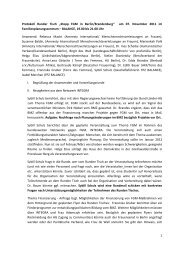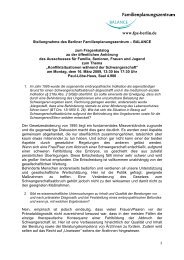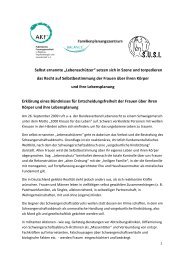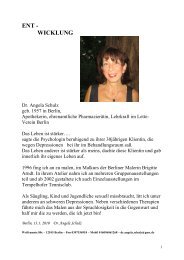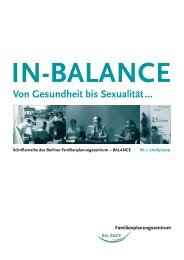Listening to African Voices - FPZ
Listening to African Voices - FPZ
Listening to African Voices - FPZ
You also want an ePaper? Increase the reach of your titles
YUMPU automatically turns print PDFs into web optimized ePapers that Google loves.
three items from the domain “Traditions”, two items fromthe domain “Loss” and three items from “Values”. The scoresobtained in each domains were counted <strong>to</strong>gether <strong>to</strong> determinethe <strong>to</strong>tal score determining acculturation.The questionnaire templates for men and women are displayedin annex 8.5 and 8.6.3.3. Implementation of the field studyAfter the five days of intense study preparation, the interviewersstarted conducting key informant interviews fora period of 16 days. Weekly meetings <strong>to</strong> discuss progressas well as difficulties and challenges were held throughoutthe period of data collection. During these meetings, theinterviewers had the opportunity <strong>to</strong> share their experiencesand <strong>to</strong> mitigate the strong emotional burden of their workthat accumulated from listening <strong>to</strong> testimonies of despairand suffering or through the repeated encounter with harshand negative reactions from the participants. They were alsoinvited <strong>to</strong> come for individual meetings with the researchconsultant for emotional support at any time.On September 7, 2010 another training and preparationmeeting <strong>to</strong>ok place with all interviewers <strong>to</strong> train them onthe conducting of structured interviews and <strong>to</strong> discuss andadjust the questionnaire templates. The phase of collectingquantitative data started after the session and continueduntil Oc<strong>to</strong>ber 31st.In order <strong>to</strong> put the study participants at ease during theinterview and <strong>to</strong> obtain high quality data, the interviewerswere able <strong>to</strong> spend up <strong>to</strong> several hours with potentialparticipants <strong>to</strong> prepare the interview and <strong>to</strong> establish anatmosphere of mutual trust. The interviews were conductedin a language chosen by the interviewee (including diverselocal languages).3.3.1. Collection of the qualitative dataWe explored different sources for the identification of keyinformants: the network of the interviewer team, <strong>African</strong>clubs and associations, counselling and intercultural centresas well as contacts of the BSG. For the interviews with healthpersonnel, we contacted gynaecologists working in neighbourhoodswith a high proportion of immigrants. The interviewersalso tried <strong>to</strong> approach health personnel of <strong>African</strong>origin assuming that people prefer <strong>to</strong> be treated by someoneof the same cultural background. When selecting keyinformants, the interviewers targeted a diversity of persons(representatives of all practicing countries) and approachedinformants from different sec<strong>to</strong>rs: health personnel, teachers,lawyers, religious leaders, government officials, youngmothers and fathers, activists, youth and students. They alsoaimed <strong>to</strong> identify participants of different age groups and ofboth sexes.For each conducted interview the interviewers submitted acover page which included socio-demographic informationand either an audio file of the interview or a written report.3.3.2. Collection of the quantitative dataDue <strong>to</strong> limited time and resources, Plan Germany had <strong>to</strong>restrict the number of countries <strong>to</strong> be included in the phaseof quantitative data collection. As it had not been possible <strong>to</strong>recruit interviewers from Egypt or <strong>to</strong> establish valuable contactsin the Egyptian communities during the first phase ofthe data collection, the sample was narrowed <strong>to</strong> immigrantsfrom countries located in Sub-Saharan Africa. If the immigrantcommunity of a country in Sub-Saharan Africa wasvery small and impossible <strong>to</strong> reach, again it was not takenin<strong>to</strong> consideration. This was the case for immigrants fromthe following countries: Mauritania, Democratic Republic ofCongo, Central <strong>African</strong> Republic and Chad. Countries outsideAfrica where FGM/C is known <strong>to</strong> be practices were also notpart of the research (Indonesia or Yemen, for example).For the quantitative survey, we aimed <strong>to</strong> identify statisticallyrepresentative sample sizes from the three countries with thelargest immigrant population (Ghana, Togo and Nigeria). Weused a confidence level of 95% and a confidence interval of5% <strong>to</strong> calculate the sample sizes. 5The immigrant communities of the remaining Sub-Saharancountries are much smaller, ranging from 12 persons (Somalia)<strong>to</strong> 483 persons (Cameroon). Reaching representativesamples within these small populations was not consideredfeasible as it would have demanded reaching the majorityof the population. For the Guinean female immigrantpopulation (56 women), it would have meant, for instance,<strong>to</strong> approach 49 of the 56 women. Hence, the decision wasmade <strong>to</strong> interview as many persons as possible and <strong>to</strong> aimat reaching about 25% of the women and 25% of the menof the immigrant population of each country. Special effortswere employed <strong>to</strong> reach high-prevalence countries (e.g.Guinea, Gambia and Ethiopia) and <strong>to</strong> approach communitieswhere the qualitative interviews had shown the need forfurther investigation (Nigeria, Togo).3.3.2.1. SamplingAs we had no means of locating the study population, wecould not carry out a random household sampling. We thereforeopted for a non-probability survey incorporating threestrategies:5 Of Sub-Saharan countries practicing FGM/C.16<strong>Listening</strong> <strong>to</strong> <strong>African</strong> <strong>Voices</strong>






